The Microsoft Surface Pro 4 Review: Raising The Bar
by Brett Howse on October 21, 2015 9:00 AM ESTBattery Life
One of the trade-offs that Microsoft has made with the Surface Pro 4 is a reduction in battery capacity. Ever since the first Surface Pro was launched, Microsoft has equipped it with a 42 Watt-hour battery. That is a large size for a tablet, but the Surface Pro has always been a larger than normal tablet too. With the Surface Pro 4, the battery capacity has been reduced slightly to 39 Wh. Part of this is the thinner chassis, and part of it is the new hybrid cooling which puts a copper plate over the battery. I can’t argue with the new cooling system, since it has clearly made a big difference in thermals.
To take a look at battery life, I’ve run both our tablet battery tests and our notebook battery tests. As with all of our battery life testing, the display is set to 200 nits for a consistent result across devices.
Tablet Battery Life
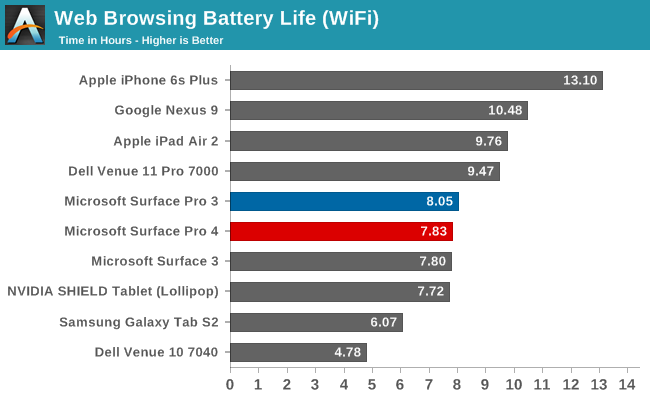
Looking at our tablet web browsing test, the Surface Pro 4 comes in right around the same battery life of the Surface Pro 3, running out of power about 13 minutes sooner. When you think about the move to Skylake, this could be taken as a disappointment, and I honestly thought it might be able to get a bit more. But the smaller battery capacity and increased pixel density both negatively impact batter life despite the CPU using a bit less power itself. I would have loved to see the larger battery stay, which would have given it about 8.5 hours, but the improved cooling system is likely a better trade-off compared to around 30 minutes of battery life.
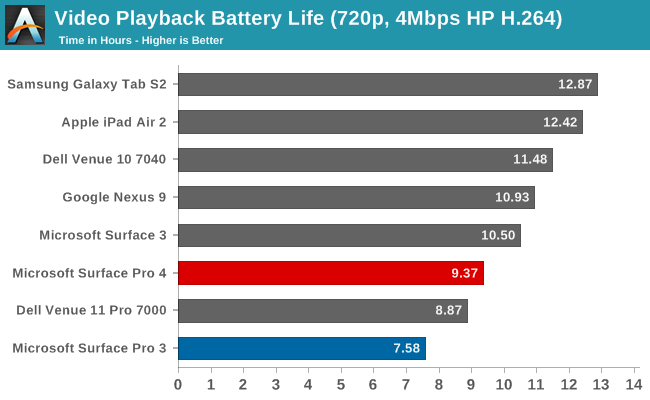
Once we shift to a more CPU-intensive workload however we start seeing significant gains. Intel has been making good progress on their video decode power consumption since Haswell, and the Surface Pro 4, despite the greater pixel density and a smaller battery, achieves 23% longer battery life than the Surface Pro 3 at this task. This is a great result and puts the Surface Pro 4 more in line with what traditional ARM based tablets can achieve.
Notebook Battery Life
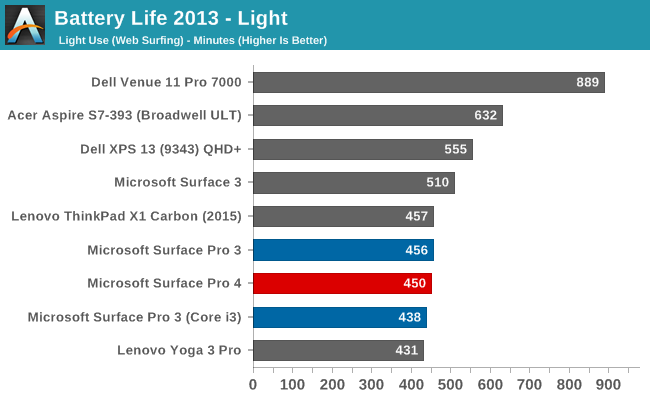
Once again the Surface Pro 4 falls right in line with the previous generations for battery life, which means that the efficiency has been improved even though the panel is much denser. While certainly not class leading in overall life, for the size of device and performance available, it is a pretty good result. Being able to keep battery life flat, while improving the display resolution, and making the device thinner and lighter, is in line with what you would expect as they pack more and more power efficient parts into the Surface Pro 4.
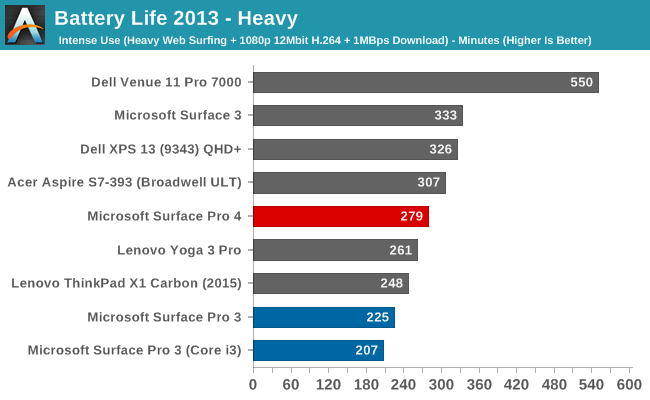
Under our heavy battery life test we can really see the improvements with Skylake. The Surface Pro 4 battery life score on our heavy battery life test outlasts the Surface Pro 3 by 21%. The heavy test involves video playback, which we have just seen in the tablet workload is significantly improved, as well as a much higher web load and a 1 MB/s file download. Once again, the Surface Pro 4 is not going to be able to compete with notebooks with much larger batteries, but for the size and weight of the device, it is a good result.
Next up let’s break down our results by energy efficiency.

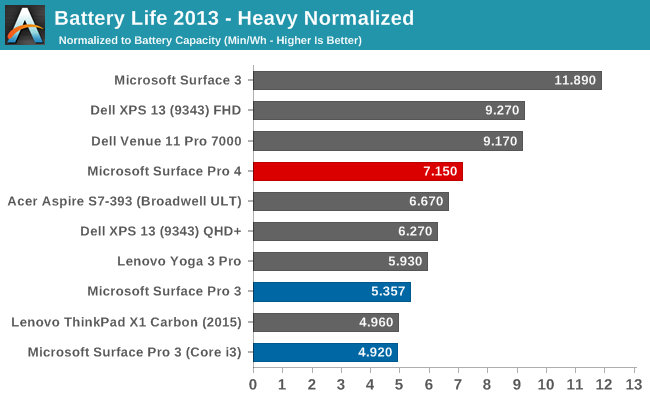
The XPS 13 is the class leader in battery life at the moment, but it achieves this with the 1920x1080 display. In order to be more comparable to the Surface Pro 4, the graph shows the higher resolution 3200x1800 version which was still able to get some pretty good battery life scores. The Surface Pro 4 manages to be more efficient than every other high resolution device we have tested, although lower resolution devices are still able to offer greater overall efficiency.
Charge Time
Microsoft has kept the same charging system from the Surface Pro 3, with the Surface Connect port providing the connection. This hasn’t changed since the last model, but I do like the magnetic connector and how well it always attaches. I kind of wish Microsoft had added a USB-C here as well, but the Surface Connect port is a pretty nice implementation. Unsurprisingly then, the charge time does not change very much at all compared to last year’s model.
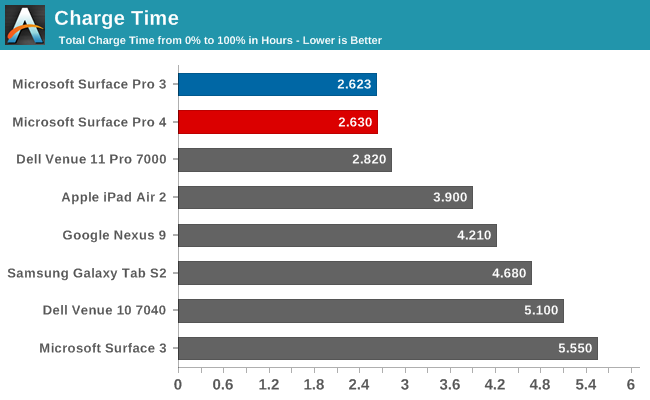
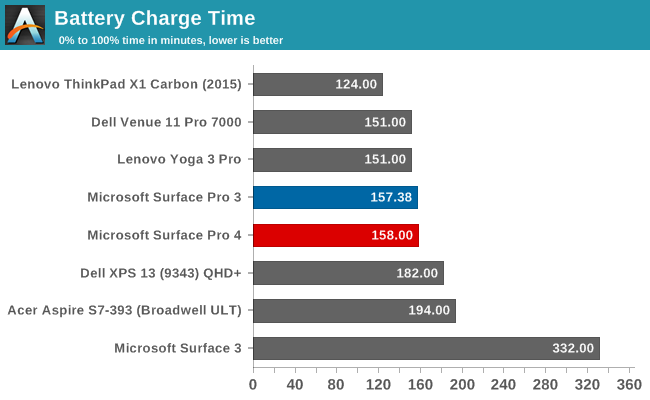
I recorded a 158-minute charge time with the standard charger. Microsoft also offers a higher wattage 60 W version for use with the Surface Book, and you can also purchase it as an accessory for the Surface Pro 4. The result with that charger? 158 minutes. The Surface Pro 4 did not dump any extra power to the battery at all with the higher wattage charger.
Once other nice part of the Surface Pro 4 charger, which also carries over, is the included 5 W USB port on the charger itself, so you can charge up your smartphone without burning two outlets. It’s a small thing, but when you are at a hotel where outlets on the desk are at a premium, it’s nice to be able to do this.


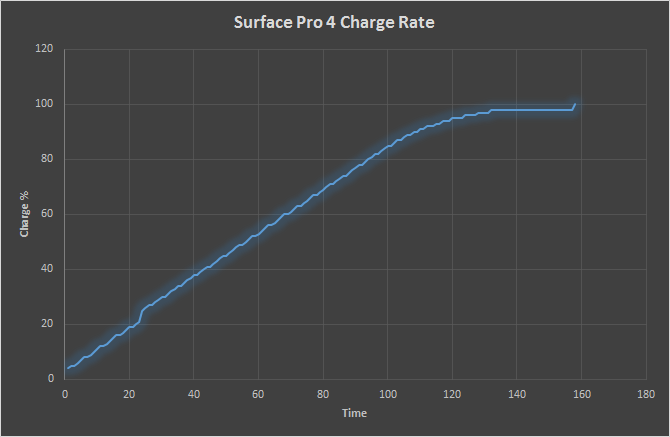








175 Comments
View All Comments
tipoo - Friday, October 23, 2015 - link
These use 15W CPUs, Iris Pro is still exclusive to full wattage models, not 15-28W ones.tipoo - Friday, October 23, 2015 - link
There is however an Iris with 64MB eDRAM for this, which the top end SP4 gets.limitedaccess - Wednesday, October 21, 2015 - link
Was there extensive load testing done to look for signs of throttling under very extended loads? I'm wondering if the Surface Book (as is actually thinner) is display some throttling compared to the SP4 due to the slightly lower numbers?With the SP3 i3 test (http://www.anandtech.com/show/8287/first-look-the-... there was no throttling under 1 run of the DOTA 2 test (assuming the same test) but further passes exposed this.
Also wondering how the orientation of the device may affect behavior as this was on the features talked about for Skylake.
Any chance of testing the pen latency as was done with the SP3 review? (http://www.anandtech.com/show/8077/microsoft-surfa...
limitedaccess - Wednesday, October 21, 2015 - link
Just realized there was more data regarding thermals but in a different section.randomlinh - Wednesday, October 21, 2015 - link
" the Surface draws heat draws heat" - I believe there's an extra "draws heat" on the cooling section :)tipoo - Wednesday, October 21, 2015 - link
Panos said "Twice as powerful as the Macbook Pro". That's definitely not true of the CPU, but it also looks like the GPU isn't there either. Seems like he was, indeed, just doing some meaningless addition of CPU, GPU, and G5 chipset. Disappoint.Other than that detail it seems pretty sweet, good battery life, trackpad, keyboard, touch, everything. Just high costtipoo - Wednesday, October 21, 2015 - link
Whoops, that was for the Surface Book, but still true.Tigashark - Monday, November 9, 2015 - link
That "Twice as fast" was in reference to Graphics performance of the dGPU version of the Surface Book, in fact they could have stated 3 times as fast.It was also a way for Microsoft to poke fun at apples far fetched and borderline outright misleading claim that the Iphone 6s was "faster than 80% of the laptops out there" .. Its hard to say MS or Apple are being totally honest.. but at least Microsoft Surface book does have some benchmarks that substantiate the claim in specific circumstances.
Remember Surface book is going after the Graphics tablet market... so their "Twice as fast" claim..even if its dGPU related, IS relevant.
I dont think Apple can substantiate their claim about the 6s.. its been proven otherwise by many websites, comparing Like with Like results in laptop vs phone still shows even the fastest phones are a few years behind mid range laptops in terms of performance.
javipas - Wednesday, October 21, 2015 - link
Great review, as I have expected. <a href=http://theunshut.com/2015/10/21/the-microsoft-surf... would add</a> the problem with lapability on these machines: the Surface Pro 4 and its predecessors are meant to be used on a table. They're not very comfortable on your lap because of the Type Cover support, and that makes them a bad choice in that situations. I use the laptop a lot on my couch and on the bed, before sleeping, and that is a problem :/ymcpa - Monday, October 26, 2015 - link
Are you using a keyboard in bed? I normally do tablet things on the couch and in bed and fold the keyboard back in favor of the touchscreen and onscreen keyboard. That said, when I needed the keyboard, I had no problem using them in bed or on the couch. Sure, it's not as comfortable as a standard laptop, but it is usable.